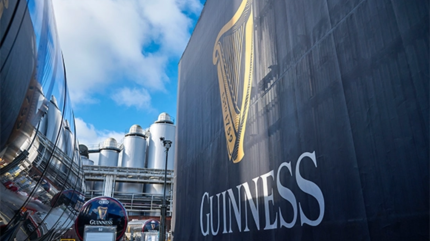
This regularly updated guide from Just Drinks will present the targets the world’s major drinks manufacturers have published on net zero – and the progress they have made so far.
According to the UN, the scientific consensus shows global temperature increases must be limited to 1.5°C above pre-industrial levels “to avert the worst impacts of climate change and preserve a liveable planet”.
To keep global warming to no more than 1.5°C – as called for in the Paris Agreement of 2015 – emissions need to be reduced by 45% by 2030 and reach net zero by 2050.
Companies link their net zero targets to three areas of emissions known as Scopes 1, 2 and 3. Under the internationally-recognised Greenhouse Gas Protocol, an organisation’s emissions are split into three ‘scopes’.
Scope 1 covers direct emissions from owned or controlled sources. A second, Scope 2, covers indirect emissions from the generation of the electricity, steam, heating and cooling bought and consumed by a reporting organisation.
Scope 3 includes all other indirect emissions that occur in a company’s value chain – and are the largest chunk of a drinks manufacturer’s output.
How well do you really know your competitors?
Access the most comprehensive Company Profiles on the market, powered by GlobalData. Save hours of research. Gain competitive edge.

Thank you!
Your download email will arrive shortly
Not ready to buy yet? Download a free sample
We are confident about the unique quality of our Company Profiles. However, we want you to make the most beneficial decision for your business, so we offer a free sample that you can download by submitting the below form
By GlobalDataSome companies have sought to have their targets validated by The Science Based Targets Initiative, or SBTi. The organisation is a partnership between the Carbon Disclosure Project, the United Nations Global Compact, World Resources Institute (WRI) and WWF.
The SBTi aims to encourage the private sector to act on climate change by supporting companies and financial institutions to understand how quickly they need to reduce emissions to align with the Paris ambition of limiting warming to 1.5°C.
The Coca-Cola Company
US drinks behemoth The Coca-Cola Co. has two “key goals” on emissions: an absolute reduction of 25% across Scopes 1, 2 and 3 by 2030 and an “ambition to achieve net zero emissions” by 2050.
The Fanta and Sprite maker’s latest report (for 2023) outlined the progress the company had made so far. Coca-Cola said it had cut emissions by 8% from a 2015 baseline. Last year, the figure stood at 7%.
Coca-Cola’s bottlers have also set targets. Coca-Cola Europacific Partners, for example, wants to reduce its absolute greenhouse gas emissions by 30% by 2030 and achieve net zero emissions by 2040.
The Coca-Cola Company estimates 30-35% of its “carbon footprint” comes from packaging. The Costa coffee owner wants all of its packaging to be recyclable by 2025.
“Our design goal targets global primary consumer packaging. For purposes of measuring progress against our ‘design’ goal, a package is recyclable
globally when there exists a system for recycling in practice and at scale by achieving a 30% post-consumer recycling rate in multiple regions,
collectively representing at least 400 million inhabitants,” The Coca-Cola Company said in its 2023 Environmental Update report. That definition is in line with the pledge to which FMCG companies have committed with NGO the Ellen MacArthur Foundation.
In 2023, 90% of Coca-Cola’s packaging was recyclable, it said, the same percentage as 2022.
By 2030, the company has a target for its packaging to contain at least 50% “recycled material”. In 2023, the proportion of “primary packaging” that contained the material was 27%. Some 17% of the PET Coca-Cola used was recycled PET (rPET).
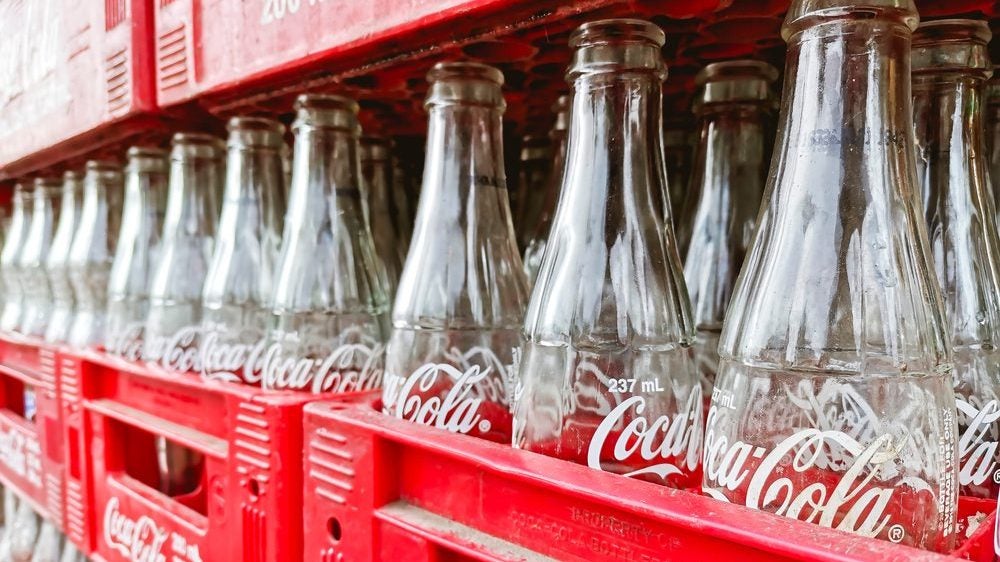
The Diet Coke brand owner, meanwhile, wants to reduce its use of virgin plastic “derived from non-renewable sources” by 3 million metric tons by 2025 compared to 2020.
In Coca-Cola’s 2023 update, it said: “We did not reduce the use of virgin
plastic in the period from 2020 to 2023 due to business growth. That said, in 2023, we reduced the absolute use of virgin plastic by more than 75,000 metric tons compared to 2022. Between 2020 and 2023, as we continued to invest in lightweighting and use of rPET, we eliminated the additional use of 1.9 million metric tons of virgin plastic.”
2022 also saw the group set a new goal for packaging. It is aiming to have at least a quarter of its beverages sold by volume “in refillable/returnable glass or plastic bottles, or in fountain dispensers with reusable packaging”, again by 2030. The 2023 report said 14% of the company’s beverage volume was sold in reusable packaging – the same proportion as 2022.
“The numbers in the company’s recent ‘Environmental Update’ make it clear — Coca-Cola is not on track to meet its reuse goal, which is terrible news for the oceans,” Matt Littlejohn, SVP at advocacy group Oceana, said.
By 2030, Coca-Cola also wants to “collect and recycle a bottle or can for each one we sell”. In 2023, the company said it collected 62% of the equivalent bottles and cans it introduced into the market, up from 61% a year earlier.
Asahi Group Holdings
The Japan-based drinks giant, home to a range of beer, soft drinks and spirits, has targets set for 2040.
Asahi wants to be “net zero” on Scopes 1, 2 and 3 by 2040, which the Super Dry brewer defines as “at least 90% emissions reductions and maximum 10% carbon removals”.
The group also has a clutch of shorter-term targets, measured against a 2019 baseline.
By 2025, Asahi is targeting a 40% cut in its Scope 1 and 2 emissions compared to 2019.
By 2030, the Nikka whisky distiller wants to have reduced its Scope 1 and 2 emissions by 70% against the 2019 baseline.
And, by the same year, Asahi is aiming to have lowered its Scope 3 emissions by 2030, again versus 2019.
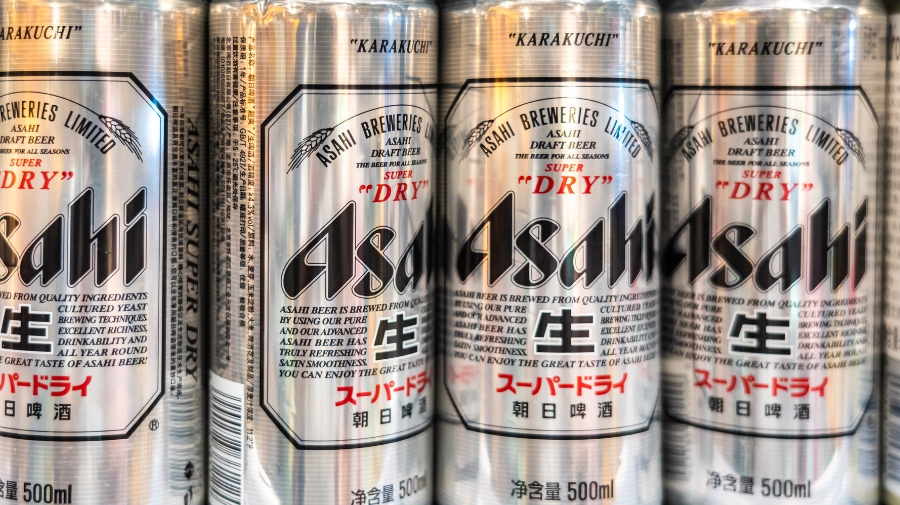
Credit: Alex Tai/SOPA Images/LightRocket via Getty Images
In a progress report issued in June 2024, the company said it had met a 2023 target for Scope 1 and 2 emissions. It had wanted to cut those emissions by 30% when compared to 2019; Asahi said it had achieved a 32% reduction. Scope 3 emissions were cut 12% in 2023 compared to 2019.
In total, Asahi measured its group emissions across all three scopes at 8,623 kt-CO2 (with, of course, the bulk – some 8,028 kt-CO2 – being Scope 3).
The report drills down even further into emissions targets for Asahi subsidiaries, including for its domestic unit, its business in Australia and for Asahi Europe and International.
On packaging, the group wants to only use “materials for plastic containers that can be utilised effectively by 2025”.
Asahi defines “effective use” as “reusable, recyclable (including technical recyclability), compostable, thermal recyclable, etc”. The company said that stood at 99% by the end of 2023.
It also wants to achieve “a 100% conversion to recycled materials, bio-based materials, etc. for PET bottles” by 2030. By the end of last year, Asahi said it had reached a level of 25%.
PepsiCo
The US food and beverage giant’s emissions targets are as follows: to cut “absolute greenhouse gas emissions across our value chain” by more than 40% by 2030, which includes a 75% reduction in emissions “from our direct operations”; and to “achieve net-zero emissions by 2040”. Those targets are based on a 2015 baseline.
In a progress report issued in June 2024, PepsiCo said it had cut its Scope 1 and 2 emissions by 33% against that 2015 criteria. By contrast, Scope 3 emissions had dropped by 1%.
“Delivering our products requires certain key inputs and activities whose emissions we cannot always control or influence. This may contribute to emissions related to the crops that make up our products, the packaging that holds them and parts of the transportation system that delivers them to our customers,” the Pepsi Max and Gatorade brands owner stated.
“We know that turning the tide will take diligence and time, but we are laying the foundation by putting substantial support and investment behind climate action and building resilience in our own operations.”
Combining the reduction across the Scopes meant PepsiCo had lowered its total emissions by 4% by the end of 2023 compared to 2015.
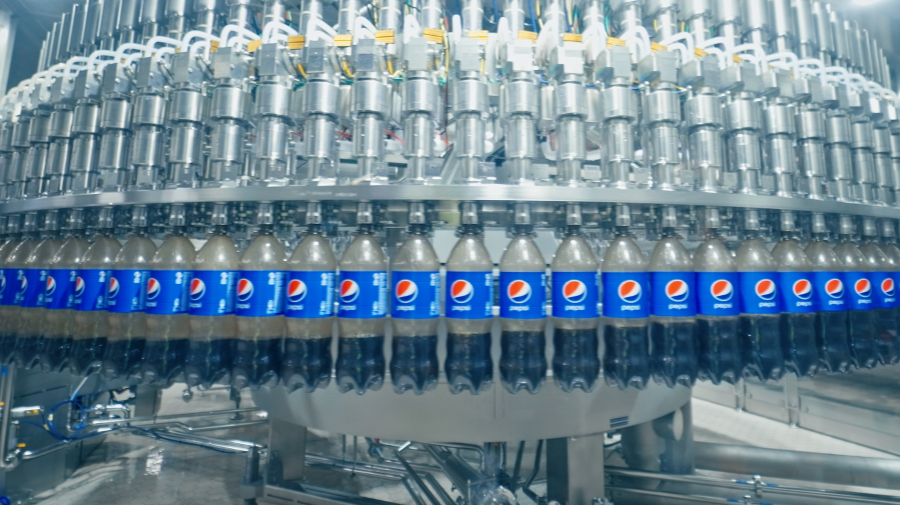
PepsiCo has also set itself a target of “regenerative agriculture practices” being used on 7m acres of land used “to grow our crops and ingredients for our products” by 2030.
In 2023, more than 1.8 million acres were using the practices, up from more than 900,000 in 2022.
Meanwhile, by 2030, the Lay’s maker wants to “sustainably source 100% of our key ingredients”, a list that will include not just the potatoes, corn and oats uses for the company’s snacks and cereal “but also key crops from third parties, such as vegetable oils and grains”. In 2023, the proportion of ingredients meeting that benchmark stood at around 58%, PepsiCo said, up from 55% a year earlier.
On packaging, PepsiCo has a “per serving” target. The company is aiming to cut its use of virgin plastic from non-renewable sources “per serving across our global beverages and convenient foods portfolio by 50%” by 2030 against a 2020 baseline. In 2023, the level had fallen by 1%. A year earlier, PepsiCo’s use had actually gone up by 2%.
By 2030, PepsiCo wants to reduce “our absolute tonnage of virgin plastic derived from non-renewable sources” by 20%, again versus a 2020 baseline. In 2023, that amount was 6% higher.
“Business growth in certain markets, particularly in markets that do not allow, or have only recently allowed, rPET in food grade packaging, has presented challenges to virgin plastic reduction,” the company said.
Anheuser-Busch InBev
The world’s largest brewer has an “ambition” to be net zero “across our value chain” by 2040, a goal it set in 2021.
In the near term, Anheuser-Busch InBev has set a target of reducing its carbon emissions by 25% by 2025.
The Budweiser brewer’s most recently-published progress report on its ambition was issued in March 2023. AB InBev’s 2022 Environmental, Social & Governance Report said the company’s absolute emissions in Scopes 1 and 2 fell 2022 by 39.2% versus a 2017 baseline.
The Stella Artois brand owner also reported a 20.7% drop in its “emissions per hectolitre of production” against the same 2017 comparison when looking at its Scope 1, 2 and 3 emissions.
AB InBev’s report gave a breakdown of its Scope 3 emissions, which accounted for 86.7% of its emissions in 2022. It has, for example, calculated that just over 42% of the Scope 3 emissions comes from “packaging materials”. To try to bring these emissions down, the brewer is moving to increase the recycled content in its packaging, invest in “low-carbon” packaging and reduce the weight of the packaging, also known as “lightweighting”.
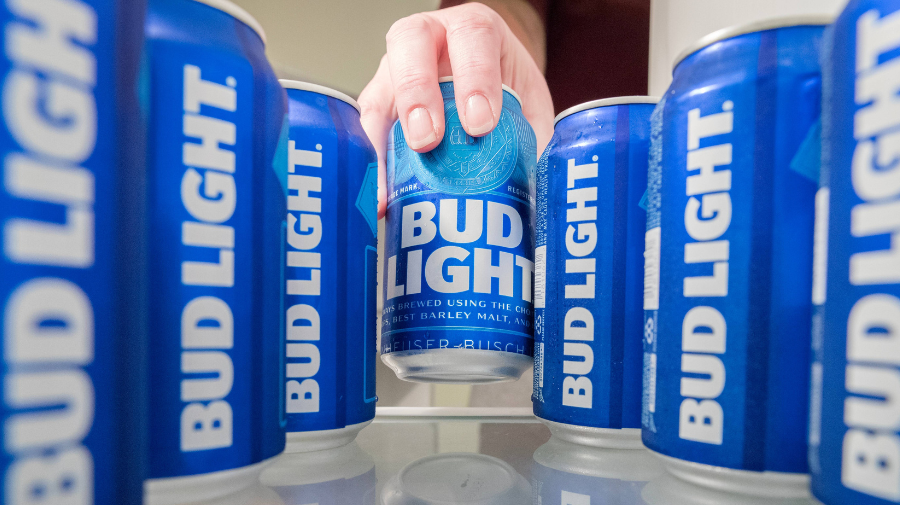
Focusing purely on the GHG emissions from packaging, some 48.2% comes from cans, with a further 31.4% from one-way glass, AB InBev noted.
The brewer highlighted the trial of a “low-carbon” can for its Corona brand in Canada. The can is made from aluminium with recycled ingot and produced from “carbon-free” hydropower, it said.
AB InBev wants all of its packaging to be “returnable or made from majority recycled content by 2025”. That figure stood at 77% in 2022.
Compared to the previous reporting year, the recycled content for cans increased slightly. However, compared to AB InBev’s 2017 baseline, the level of recycled content decreased in 2022. The company pointed to the “significant growth of our volume in cans since 2020”, which it said drove increased imports of can sheet amid a “lower availability” of recycled content. “We are working closely with our can sheet suppliers to increase recycled content,” the report read.
Another notable chunk of AB InBev’s Scope 3 emissions comes from keeping its products cool. Here, the Leffe brewer says it is looking to install “more efficient refrigeration with innovative cooling solutions”. It is also looking to “scale” the use of more renewable electricity “across our retailers globally”.
And the brewer also detailed its estimates for GHG emissions by crops. Unsurprisingly, the biggest portion (45.7%) comes from barley, followed by rice at 39.6%. “Agriculture,” AB InBev said, “represents 14.8% of our value chain emissions”. The company is investing in regenerative agriculture projects in countries including Mexico and Argentina.
Diageo
The world’s largest spirits business’ environmental targets include two goals on emissions for 2030.
By that year, the Johnnie Walker brand owner wants to “become net zero carbon in our direct operations”, covering Scopes 1 and 2.
On Scope 3, Diageo is aiming to “reduce our value chain carbon emissions by 50%” by 2030.
The group’s 2030 targets also include an aim for to only use renewable electricity at its “direct operations”.
Diageo is among a clutch of major drinks companies that formed the REfresh Alliance in 2024 to try to speed up the adoption of renewable energy in their supply chains.
On packaging, Diageo wants to see a 10% reduction in packaging weight and increasing the percentage of recycled content in its packaging to 60%.
In Diageo’s fiscal 2023 annual report, the company said it had cut the carbon emissions from its carbon emissions by 5.4%. It pointed to the “beneficial impact” of its biomass plants in east Africa and its use of liquid biofuel and renewable electricity.
Across Diageo’s whole value chain, the group saw its Scope 3 emissions fall by 1.2%. However, the Tanqueray gin owner added: “We remain behind our 2020 baseline by 20.7%.”
Emissions from packaging fell, Diageo said, amid moves to invest in the lightweighting of glass, removing cartons and switching to lower-carbon materials.
However, emissions linked to capital goods increased. The company said these included “investments in plants that enable our low-carbon transition”.
On sourcing, Diageo has a regenerative farming project in Ireland, aimed at reducing the carbon emissions of barley production. Last year, the company also started pilot ‘regen ag’ projects in Scotland and Mexico.
Overall, Diageo said its direct and indirect carbon emissions stood at 401,000 tonnes CO2e in its fiscal year 2023, compared to 424,000 the year previous.
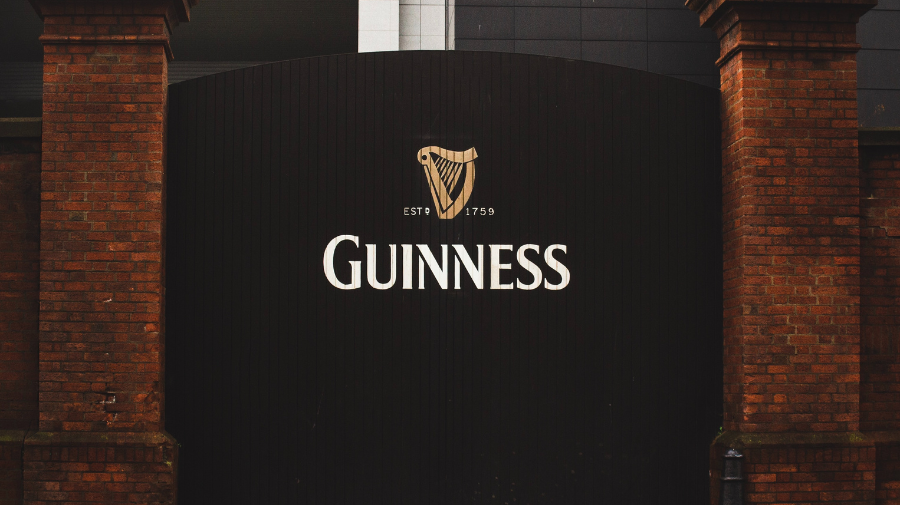
On packaging, the Guinness owner cut the weight of its packaging by 4.4% year-on-year but said the amount it used was 14.9% above a 2020 baseline due to increased production.
Recycled content made up 39% of the packaging, a 1.2% fall on the previous fiscal year. Diageo pointed to a shortage of cullet, a feedstock for recycled glass, in the UK and North America. The company said: “We continue to face challenges in sourcing quality recycled glass and PET, though we are working with suppliers and industry peers to strengthen recycling infrastructure.”
Diageo’s 2030 emissions targets are approved by the SBTi. However, the company’s longer-term net-zero goal is classified as “commitment removed” on the SBTi website. Diageo, like dozens of other companies, is in the process of submitting an update to the SBTi and is aiming to have the target reviewed by the organisation within the next 12 to 18 months.
Carlsberg
The Denmark-based brewer, home to brands including Tuborg, 1664 and Carlsberg, is aiming to reduce its “value chain emissions” by 30% by 2030.
By the same year, Carlsberg wants to cut its value chain emissions per hectolitre of beer and beverages by 30% from a 2015 baseline.
It also has a target of achieving “net-zero carbon emissions across our entire value chain by 2040”.
Carlsberg has yet to submit the 2040 goal for validation by the SBTi “because we must also update our 2030 target – the near-term value chain target [for] Scope 3”, Carlsberg tells Just Drinks. “We expect to complete this work during 2024.” In its 2023 ESG report, the brewer noted how the SBTi’s “standards have … evolved” since the initiative first approved its 2030 target.
On packaging, the company wants all of its packaging to be recyclable, reusable or renewable by 2030. Carlsberg, meanwhile, has set a target for 90% of its bottles and cans are collected and recycled after use. It has also cut its use of “virgin fossil-based plastics” in half and for its bottles and cans to contain 50% recycled content.
And, on agricultural sourcing, the company wants to have 30% of its raw materials to come “from regenerative agricultural practices” and be “sustainably sourced” by 2030. Carlsberg is aiming for all its raw material inputs to qualify as such ten years later. As of 2023, less than 1% of the inputs were deemed to meet the criteria.
In Carlsberg’s 2023 ESG report, the company said “total brewery emissions” fell 6% (to 301,000 tonnes CO2e) compared to 2022 – and by 57% versus 2015. A second metric of “relative emissions per hectolitre of beer” has also been published. That’s 59% lower than in 2015, with Carlsberg pointing to better efficiency in its breweries and investment in “renewable capacity”.
Across the wider supply chain, Carlsberg said its “emissions per hectolitre of beer” fell 16% between 2015 and 2022 (to 47kg CO2e/hl) “putting us on track to meet our 30% relative reduction target by 2030”.
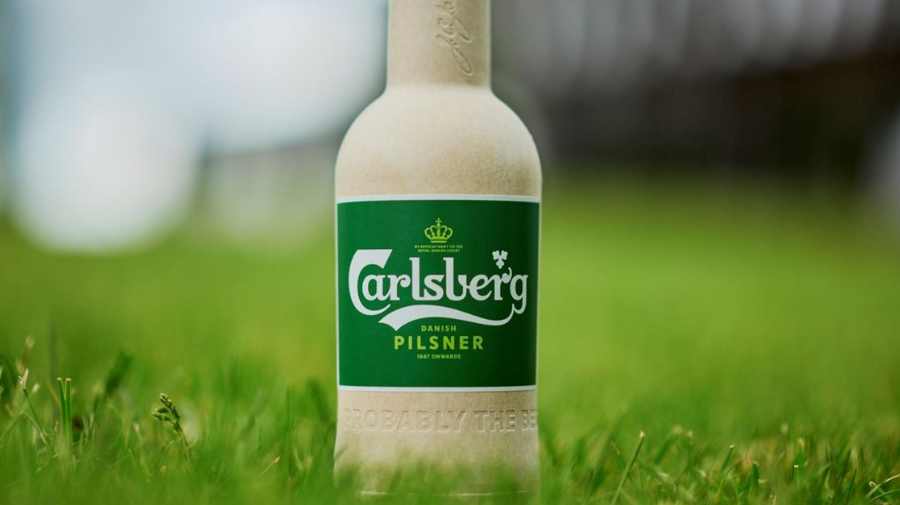
Turning to packaging, in 2022, Carlsberg says 74% of its bottles and cans were collected and recycled. The recycled content in its packaging, meanwhile, stood at 34%.
In the same year, the group said it used roughly 58,000 tonnes of virgin fossil-based plastic, which it added was down 3% on 2019.
Carlsberg does note that its figures on virgin plastic, the recycled content of its packaging and on recycling/collection rates are “based on available data; as data accuracy improves over time the results of this analysis may change”.
The brewer has made some notables moves on packaging – ditching plastic on multi-can packs in markets including the UK and trialling a paper-based bottle for its namesake beer.
Its 2023 ESG report states: “Following testing and consumer sampling of our bio-based and fully recyclable Gen 2.0 Fibre Bottle in 2022, we are now working on optimisations towards Gen 3.0. PEF, a plant-based material used in these innovative bottles, will be sourced from [supplier] Avantium’s new flagship plant, which will be starting up production in 2024.”
Heineken
The Dutch brewing behemoth has its ESG targets under its Brew a Better World 2030 strategy.
Heineken provided an update on its progress in its overall 2023 annual report.
Last year, the brewer’s target of being net zero in its “full value chain” by 2040 was approved by the SBTi.
Heineken also received SBTi backing for a Scope 3 target under the initiative’s Forest, Land and Agriculture (FLAG) guidance.
The FLAG scheme “provides the world’s first framework for companies in land-intensive sectors to set science-based targets that include land-based emission reductions and removals”, the SBTi says.
On the back of SBTi guidance, Heineken is aiming to “neutralise a maximum 10% of our unabated emissions by investing in high-integrity removal carbon credits”.
By the end of 2023, the Amstel brewer had cut its Scope 1 and 2 emissions by 34% compared to a 2018 baseline (and 19% versus 2022). Heineken pointed to gains in production and distribution. Some 77% of the electricity used in its direct operations is from renewable sources, up from 58% in 2022.
It had also reduced its Scope 3 emissions by 20% versus the same 2018 baseline.
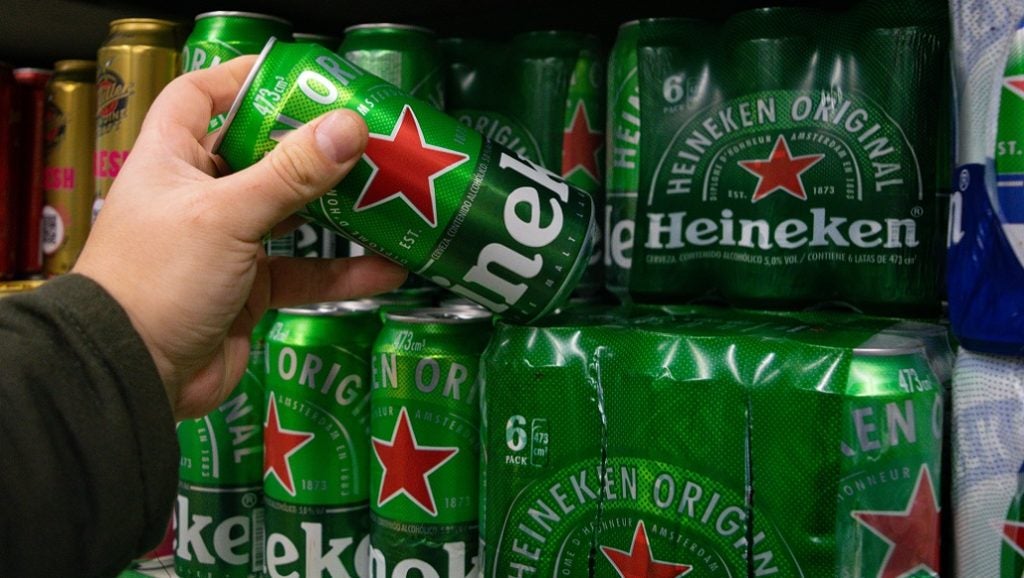
From this year, in the wake of the FLAG award, Heineken will start reporting against updated 2030 scope 3 reduction targets. These will include a 30% reduction in the company’s Scope 3 agriculture emissions (FLAG) and a 25% cut in its Scope 3 emissions that are not linked to agriculture.
In 2023, 14.1m tonnes of CO2e of emissions were classified as Scope 3, down 12% on the year. Heineken said lower volumes meant it bought less packaging. It also pointed to “changes in methodology”. Group-wide, the company generated 15.3m tonnes.
Heineken says its work with suppliers includes a “low-carbon farming” programme to tackle carbon emissions and improve carbon sequestration, as well as supporting suppliers’ moves to move to renewable energy sources.
The brewer says it worked on almost 300 pilots in 2023, in markets including Mexico, Brazil, France, the UK and the US. It wants to hit 500 pilots by 2025 “and to scale the low-carbon farming programme across volume, crops and regions”.
So far, 13 of Heineken’s suppliers (which the brewer says makes up around 63% of its agriculture-related emissions) “are committed to SBTi, out of which five have already set targets”.
Turning to packaging (which accounts for 31% of Heineken’s emissions) the Strongbow brand owner has three 2023 targets. The group is aiming for 50% recycled content in its bottles and cans. The company wants 43% of its volumes to be sold in reusable formats. And it has a goal of 99% of its packaging to be “recyclable by design”.
The 2023 annual report states: “The majority of our packaging is already designed to be recyclable and is recycled at scale across the globe. Our two main challenges are to improve the recyclability of our caps and secondary packaging film. To do so we need to improve the designs and recycling at scale through market interventions. We will also ensure all innovations meet the recyclable by design standards and are further integrating this into our sustainable innovation process.”
Pernod Ricard
Pernod Ricard, home to brands including Mumm Champagne and Beefeater gin, has its own “roadmap to 2030”.
The France-based wine-and-spirits group says it is “committed” to halving “the intensity of our overall carbon footprint” by 2030. It has also pledged to follow a “net zero by 2050 trajectory”.
According to Pernod Ricard’s most recent annual report, which was published in November 2023, the company has cut its Scope 1 and 2 carbon-dioxide emissions by 12% since its 2018 fiscal year– and lowered its Scope 3 CO2 emissions by 18% over the same time-frame.
The Jacob’s Creek brand owner wants to reduce the “absolute value” of its Scope 1 and 2 emissions by 54% by 2030. It has also set a Scope 3 target, which is to cut the “financial intensity” of those emissions by 50% by the same year versus that fiscal 2018 baseline.
Despite some FMCG majors moving away from carbon-neutral projects, Pernod Ricard is investing in its production network with a series of “carbon neutral” programmes. It wants to make its Midleton distillery in Ireland “carbon neutral”, a change scheduled to be completed by 2026.
At Chivas Brothers, the group’s Scotch whisky arm, the business is aiming for “carbon-neutral distillation” by the same year. By 2023, Pernod Ricard has a target for its Absolut vodka brand to be carbon neutral. In Sweden, where Absolut is distilled, the group has been working on using hydrogen fuel to power a glass-melting furnace at the local site of packaging supplier Ardagh.
Across the Atlantic, the company is building a “carbon neutral” distillery for its Jefferson’s Bourbon brand in the US.
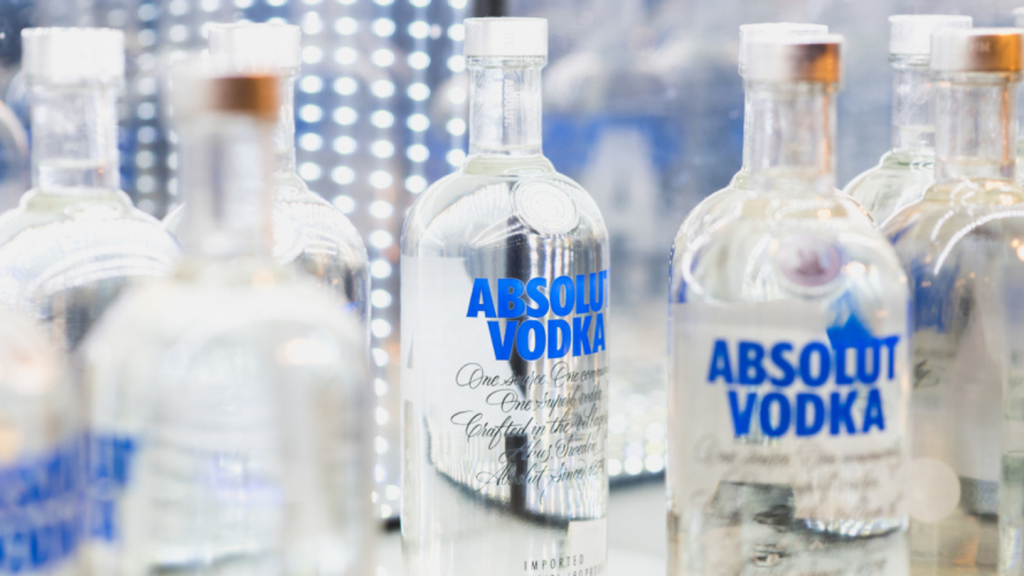
Pernod Ricard’s goals on packaging include a target for all its packaging to be “recyclable, reusable, or compostable by 2025”. Some 98% of the company’s packaging was classified as such according to the November 2023 annual report.
The company said it was “actively working towards increasing recycled content in glass to 50% and reducing virgin plastic by 5% by 2025 versus fiscal year 2020”.
In June 2023, Pernod Ricard defended the launch of a paper bottle for Absolut amid “greenwashing” claims from industry watchers. The bottle was launched in 22 Tesco stores in the UK city of Manchester.
2023 also saw the company acquire a minority stake in circular packaging company EcoSpirits. Pernod Ricard had been trialling a closed-loop packaging concept in south-east Asia using technology developed by EcoSpirits.
Stock Spirits Group
Pan-European distiller Stock Spirits has a target to cut its Scope 1 and 2 greenhouse gas emissions by 42% against a 2015 baseline by 2030.
The Clan Campbell whisky owner is looking to reduce its Scope 3 emissions by “approximately 20%”.
Stock Spirits plans to set its Scope 3 “intensity-based reduction target” by 2025. The goal will be “equivalent to approximately a 20% absolute reduction”
The company plans to set its final reduction targets for SBTi validation in 2025.
The Scope 3 target does not include the group’s new distillery in the Polish city of Lublin distillery or M&A.
Stock Spirits completed the construction of the factory in Lublin earlier this year, a site the company said is the biggest distillery in Poland.
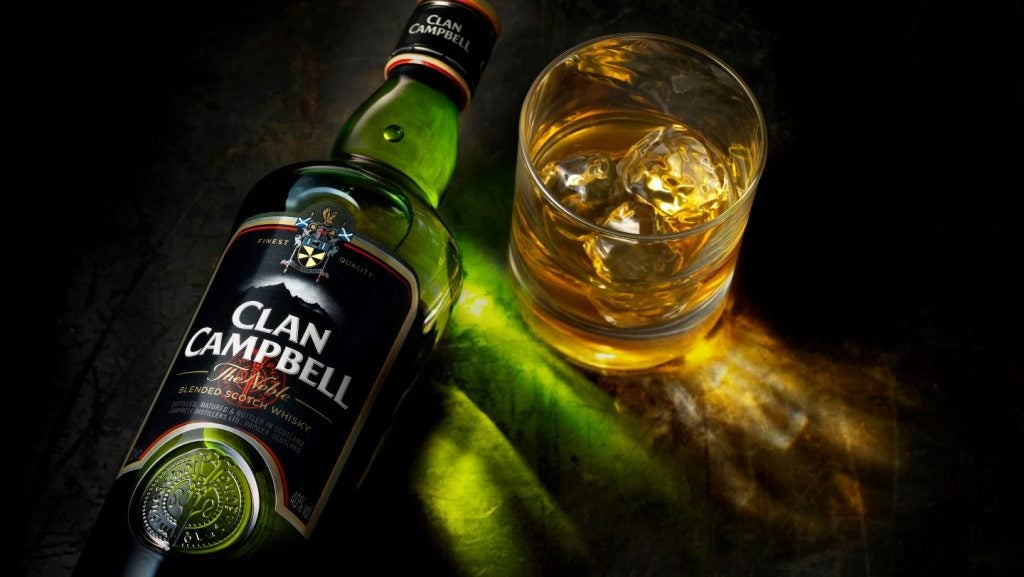
In August 2024, the Sierra Tequila owner issued its 2023 Sustainability Report. The company said it had cut its Scope 1 GHG emissions by 27.2% when compared to 2015 to 26,587.3 tCO2e.
On Scope 2, Stock Spirits said it had achieved a 7.8% reduction of its “location-based” emissions to 8,573.6 tCO2e and a 96.9% fall in “market-based” emissions to 353.3 tCO2e.
The group said the drop in market-based emissions had been “mainly related to switching to renewable energy sources”. It has a target for all of the electricity used in its production sites to come from renewable sources in 2025.
Treasury Wine Estates
Australia-based Treasury Wine Estates, home to brands including Penfolds and Wolf Blass, has an over-arching goal to reach net zero for Scope 1 and 2 emissions by 2030.
In the listed group’s 2024 financial year, it generated 16kt CO2e of emissions under those two scopes – accounting for 3.8% of its total emissions.
As you’d expect, TWE’s Scope 3 emissions made up more than 90% of its emissions during the 2024 fiscal period, as per a report issued by the company covering the year.
The Daou wine brand owner provided a breakdown of its Scope 3 emissions – with 27.2% defined as coming from “TWE operations” and 26.4% from “bottling and packaging”. A further 18.1% is classed as from “logistics, warehousing and distribution”.
TWE says it reports its Scope 3 emissions with a lag of one year due to the time it takes to source data. In the company’s 2022 fiscal year, the emissions stood at 496.1kt CO2e and fell to 404.8kt CO2e in the 2023 financial year.
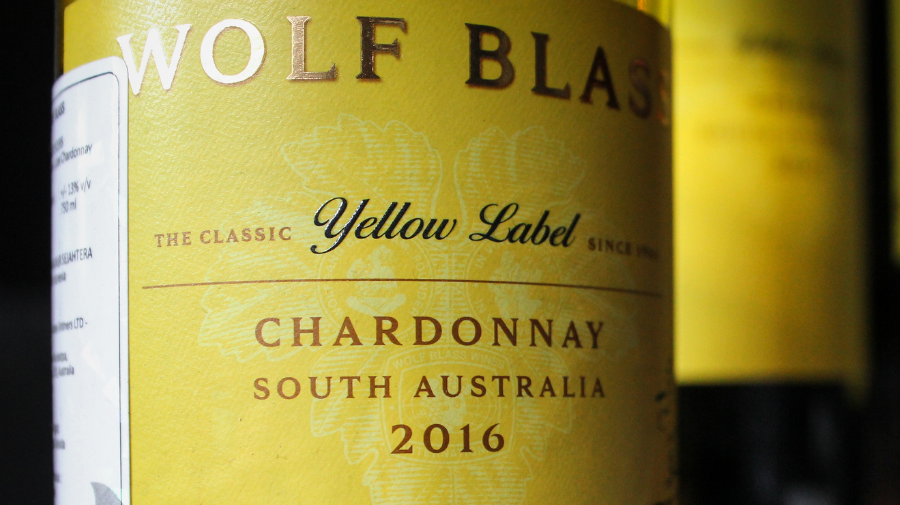
“We’re engaging with our supply chain to encourage decarbonisation and further
understand our associated emissions profile (Scope 3), which is a longer-term programme of work, given the complexities involved,” the report states.
During the most recent year under review, TWE said it sent 110 requests to suppliers for information on their emissions. The requests covered “36% of supplier spend but approximately 60% of emissions”. Some 19 suppliers took part in the survey.
“Many of our suppliers are in the early stages of emissions data collection or have not fully accounted for their scope 1 and 2 emission footprints and were unable to provide sufficient quality data,” TWE said. “A total of 19 suppliers were able to participate in the survey, indicating there is more work to do to build capability and reporting system maturity among our suppliers.



